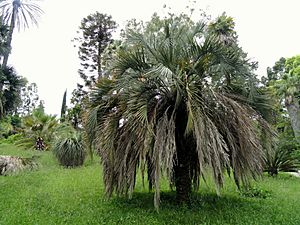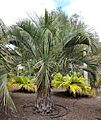Butia facts for kids
Quick facts for kids Butia |
|
|---|---|
 |
|
| Butia odorata | |
| Scientific classification |
|
| Kingdom: | Plantae |
| Clade: | Tracheophytes |
| Clade: | Angiosperms |
| Clade: | Monocots |
| Clade: | Commelinids |
| Order: | Arecales |
| Family: | Arecaceae |
| Subfamily: | Arecoideae |
| Tribe: | Cocoseae |
| Genus: | Butia (Becc.) Becc. |
| Type species | |
| Butia capitata |
|
Butia is a genus of palm trees. These palms belong to the Arecaceae family. They grow naturally in South America. You can find them in countries like Brazil, Paraguay, Uruguay, and Argentina.
Many types of Butia palms grow yummy fruits. People sometimes use these fruits to make drinks and other foods. The name Butia comes from a local Brazilian word for these plants.
What Are Butia Palms Like?
These palms are known as 'feather palms'. This means their leaves look like big feathers. Each leaf can be up to 3 meters (about 10 feet) long. They usually curve downwards.
Butia palms come in different sizes. Some are very small, like the Butia campicola. These rarely grow taller than 40 centimeters (about 16 inches). Others can be small trees, like B. yatay. These can grow up to 12 meters (about 39 feet) tall!
One special type is Butia odorata. It is one of the toughest feather palms. It can handle cold temperatures, even down to about −10 °C (14 °F). Because it's so strong, people grow it in many places. You can find it in areas with warm weather or mild winters.
Different Kinds of Butia Palms
There are many different types, or species, of Butia palms. Each one has its own special features. They grow in various parts of South America. Some are found only in one country, while others spread across several.
For example, Butia capitata grows in Brazil. The Butia eriospatha is also known as the Woolly Butia Palm. Another well-known one is Butia odorata. It's often called the South American jelly palm or pindo palm. Its fruit is used to make jelly!
The Butia paraguayensis is a smaller type. It's sometimes called the Dwarf Yatay Palm. The Butia yatay is a taller palm, also known as the Yatay Palm.
Scientists are always studying these palms. They sometimes find new species. They also learn more about how different types are related.
Images for kids
See also
 In Spanish: Butia para niños
In Spanish: Butia para niños








